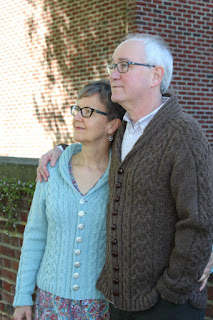Constructing Ingefred
The Ingefred doesn't come right off the needles looking like this (crazy face aside).
Actually, this is exactly what it looks like just after finishing and before blocking and adding ear flaps.
And after blocking...ah, that's better.
But let's back up a little. Before you graft the band together, think about cutting your lining while you can lay your band out flat. This way you can be sure it's the right size.
Lay your fleece out on a self-healing cutting board. Measure the length and width of your band--mine is three inches by twenty inches. Grab your yardstick and your rotary cutter and use the board as a guide to measure and cut the fleece.
Leave about a quarter inch of room at each end. You do not want the fleece to come all the way to the seam. It's good to leave a little space so that the hat can stretch a bit. The hat will stretch, but the fleece won't.
You can either go ahead and whip stitch your lining to the band before joining the ends or put it aside until after the whole hat is done (my choice). Either way, you've gotten that part out of the way.
Now let's talk about the hardest part--at least for me, anyway.
Grafting the band together is a little mindbending, because you're not just working with knit stitches. You need to know how to transition from knit stitches to purl stitches and back again within the piece. If just reading those last couple of sentences gives you the tremors, you can just seam your band together. The light grey Ingefred hat at the top has been grafted (if imperfectly) and the dark grey headband below it has been seamed. You can see that seaming works just fine. Of course, if you plan to skip the grafting, you do not need to do a provisional cast on at the beginning of the project. Just cast on as you normally would do.
I am saving an in-depth tutorial of this convoluted grafting technique for another post (because I am still trying to perfect it myself!), but here are a couple of tips. If you are already proficient with grafting knit stitches, you know that you begin your graft with a length of yarn on a yarn needle coming from the top set of two sets of live stitches held together.
As usual, with yarn coming from the first stitch on the upper needle, insert the yarn needle into the first stitch on the lower needle purlwise.
Keeping the yarn below both needles (at all times), then insert the needle into the first stitch on the upper needle knitwise.
These two maneuvers represent the second half of both of those stitches, because the real action does not come until the next part. Insert yarn needle with working yarn into the first stitch on the lower needle knitwise and take the stitch off the needle. Then insert the yarn needle into the next stitch of the same needle purlwise and leave it on the needle. Insert the yarn needle into the first stitch on the upper needle purlwise and take it off the needle. Insert the yarn needle into the next stitch on the upper needle knitwise and leave it on the needle. If this were a piece with knit stitches all the way across, we would just repeat this over and over until the end. Knit/purl (lower needle); purl/knit (upper needle).
However, on the Ingefred band we run into a purl stitch after the first three stitches. What to do? Okay, take a deep breath, get in a comfortable position, and try this. On the knit stitch before the purl stitch, instead of "knit/purl" on the lower needle, you are going to "knit/knit." And on the upper needle instead of "purl/knit" you will "purl/purl." Then you just do the whole thing backwards and "purl/knit" on the lower needle and "knit/purl" on the upper needle.
When you are almost done with the purl stitches, on that last purl stitch before the next set of knit stitches, work a "purl/purl" on the lower needle and a "knit/knit" on the upper needle and you're back to where you started.
When you are done you will want to cry because it will look like this, but that's only because you haven't tightened up your stitches. Once you tidy the stitches it will look more like the light grey grafted hat up a few pics from here (or better!)
Now, get a nice cup of chamomile tea and close your eyes. You need a rest.
Feel better now? Okay, time to pick up stitches and work the crown and then the ear flaps. Once you're done with those, here's one last tip for you.
For lining the ear flaps, I would suggest making a little template. You know you'll want to make more than one of these fun hats, and a template makes it so easy to cut the little triangles.
That went a little long, but I hope something here makes the Ingefred Hat an easier project for you. Despite the length of this post, the hat is quite a quick project, especially if you love cables like I do. You become entranced with the cable action and before you know it, it's time to make pompoms. Or not.
So many choices with the Ingefred!














Comments
Thanks!